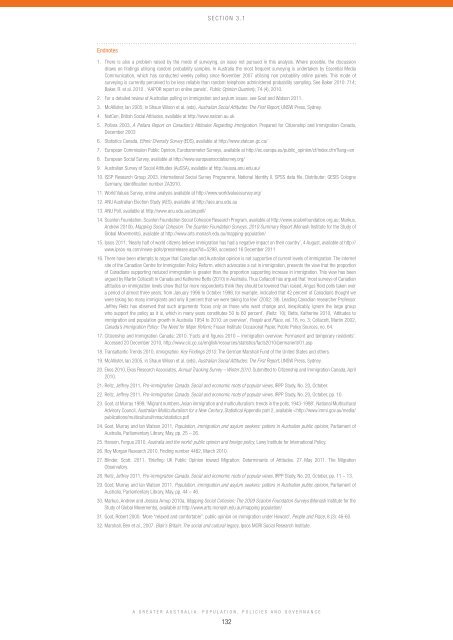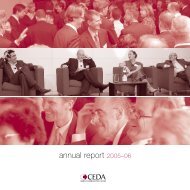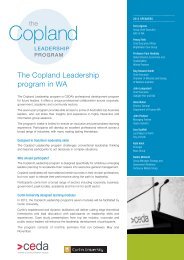A Greater Australia: Population, policies and governance - CEDA
A Greater Australia: Population, policies and governance - CEDA
A Greater Australia: Population, policies and governance - CEDA
- No tags were found...
You also want an ePaper? Increase the reach of your titles
YUMPU automatically turns print PDFs into web optimized ePapers that Google loves.
Section 3.1Endnotes1. There is also a problem raised by the mode of surveying, an issue not pursued in this analysis. Where possible, the discussiondraws on findings utilising r<strong>and</strong>om probability samples. In <strong>Australia</strong> the most frequent surveying is undertaken by Essential MediaCommunication, which has conducted weekly polling since November 2007 utilising non probability online panels. This mode ofsurveying is currently perceived to be less reliable than r<strong>and</strong>om telephone administered probability sampling. See Baker 2010: 714;Baker, R. et al. 2010 , ‘AAPOR report on online panels’, Public Opinion Quarterly, 74 (4), 2010.2. For a detailed review of <strong>Australia</strong>n polling on immigration <strong>and</strong> asylum issues, see Goot <strong>and</strong> Watson 2011.3. McAllister, Ian 2005, in Shaun Wilson et al. (eds), <strong>Australia</strong>n Social Attitudes: The First Report, UNSW Press, Sydney.4. NatCen, British Social Attitudes, available at http://www.natcen.au.uk5. Pollara 2003, A Pollara Report on Canadian’s Attitudes Regarding Immigration. Prepared for Citizenship <strong>and</strong> Immigration Canada,December 20036. Statistics Canada, Ethnic Diversity Survey (EDS), available at http://www.statcan.gc.ca/7. European Commission Public Opinion, Eurobarometer Surveys, available at http://ec.europa.eu/public_opinion/cf/index.cfm?lang=en8. European Social Survey, available at http://www.europeansocialsurvey.org/9. <strong>Australia</strong>n Survey of Social Attitudes (AuSSA), available at http://aussa.anu.edu.au/10. ISSP Research Group 2003, International Social Survey Programme, National Identity II, SPSS data file, Distributor: GESIS CologneGermany, Identification number ZA3910.11. World Values Survey, online analysis available at http://www.worldvaluessurvey.org/12. ANU <strong>Australia</strong>n Election Study (AES), available at http://aes.anu.edu.au13. ANU Poll, available at http://www.anu.edu.au/anupoll/14. Scanlon Foundation, Scanlon Foundation Social Cohesion Research Program, available at http://www.scalonfoundation.org.au; Markus,Andrew 2010b, Mapping Social Cohesion: The Scanlon Foundation Surveys, 2010 Summary Report (Monash Institute for the Study ofGlobal Movements), available at http://www.arts.monash.edu.au/mapping-population/15. Ipsos 2011, ‘Nearly half of world citizens believe immigration has had a negative impact on their country’, 4 August, available at http://www.ipsos-na.com/news-polls/pressrelease.aspx?id=5298, accessed 16 December 201116. There have been attempts to argue that Canadian <strong>and</strong> <strong>Australia</strong>n opinion is not supportive of current levels of immigration. The internetsite of the Canadian Centre for Immigration Policy Reform, which advocates a cut in immigration, presents the view that the proportionof Canadians supporting reduced immigration is greater than the proportion supporting increase in immigration. This view has beenargued by Martin Collacott in Canada <strong>and</strong> Katherine Betts (2010) in <strong>Australia</strong>. Thus Collacott has argued that ‘most surveys of Canadianattitudes on immigration levels show that far more respondents think they should be lowered than raised. Angus Reid polls taken overa period of almost three years, from January 1996 to October 1998, for example, indicated that 42 percent of Canadians thought wewere taking too many immigrants <strong>and</strong> only 8 percent that we were taking too few’ (2002: 39). Leading Canadian researcher ProfessorJeffrey Reitz has observed that such arguments ‘focus only on those who want change <strong>and</strong>, inexplicably, ignore the large groupwho support the policy as it is, which in many years constitutes 50 to 60 percent’. (Reitz: 10); Betts, Katherine 2010, ‘Attitudes toimmigration <strong>and</strong> population growth in <strong>Australia</strong> 1954 to 2010: an overview’, People <strong>and</strong> Place, vol. 18, no. 3; Collacott, Martin 2002,Canada’s Immigration Policy: The Need for Major Reform, Fraser Institute Occasional Paper, Public Policy Sources, no. 64.17. Citizenship <strong>and</strong> Immigration Canada: 2010. ‘Facts <strong>and</strong> figures 2010 – Immigration overview: Permanent <strong>and</strong> temporary residents’.Accessed 20 December 2010, http://www.cic.gc.ca/english/resources/statistics/facts2010/permanent/01.asp18. Transatlantic Trends 2010, Immigration. Key Findings 2010. The German Marshall Fund of the United States <strong>and</strong> others.19. McAllister, Ian 2005, in Shaun Wilson et al. (eds), <strong>Australia</strong>n Social Attitudes: The First Report, UNSW Press, Sydney.20. Ekos 2010, Ekos Research Associates, Annual Tracking Survey – Winter 2010. Submitted to Citizenship <strong>and</strong> Immigration Canada, April2010.21. Reitz, Jeffrey 2011, Pro-immigration Canada. Social <strong>and</strong> economic roots of popular views, IRPP Study, No. 20, October.22. Reitz, Jeffrey 2011, Pro-immigration Canada. Social <strong>and</strong> economic roots of popular views, IRPP Study, No. 20, October, pp. 10.23. Goot, at Murray 1999, ‘Migrant numbers, Asian immigration <strong>and</strong> multiculturalism: trends in the polls, 1943-1998’, National MulticulturalAdvisory Council, <strong>Australia</strong>n Multiculturalism for a New Century, Statistical Appendix part 2, available





